A look at Early Netherlandish manuscript illumination in the Walters Art Museum

Recently I had the opportunity to view a selection of 15th and early 16th century Netherlandish manuscripts at the Walters art museum. I'd like to showcase some interesting highlights from the collection. The Walters' collection is enormous and undoubted there is much area for research remaining. Images are reproduced courtesy of the Walters Museum, which has digitized the works.

Ms. W.195
This manuscript is a book of hours illuminated in the style of Willem Vrelant. Willem Vrelant was one of the most prolific, influential, and commercially successful illuminators working in Bruges during the third quarter of the 1400s. It is likely that he had a very large workshop with many assistants to produce such an abundant ouvre.

This manuscript follows many of the typical themes of a late 15th century book of hours, with the fairly uniform Vrelant design. One interesting oddity I spotted was the large size of the heads of some of the characters in the historiated initials. Perhaps if other books from the school of Vrelant have a similar pattern of large heads when conforming to tight spaces, it would be possible to identify the hand of a particular assistant or follower. I will keep this in mind when I look at manuscripts in this style in the future.
Walters Ms. W.220

The Walters' catalogue attributes this book of hours to Vrelant himself together with his workshop. comparing with the book above, the quality of the illumination in this book is noticeably much higher. The fact that the patrons are depicted, and the book contains a unique scene of the Mocking and Buffeting of Christ supports this attribution.
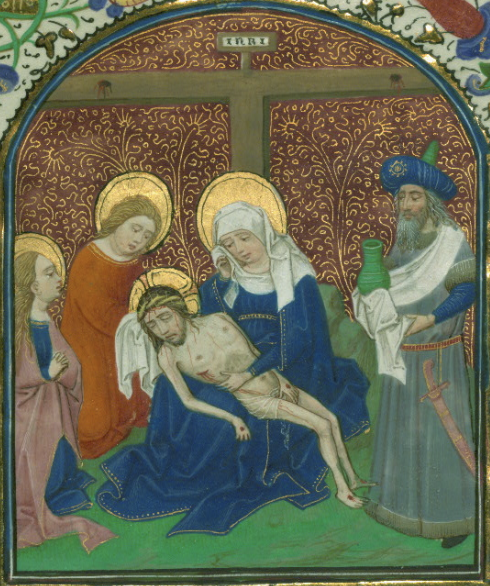
A few things stood out about this book to me. One of them is the use of textured/embroidered red backgrounds in place of landscapes or interior architecture in a number of miniature. This style harkens back to manuscripts produced in the first half of the 15th century and would have gone out of style by the end of his career. The Walters' catalogue dates this manuscript Ca. 1450-1455, and likely this background pattern is one of the reasons for that, likely along with the fashion and other details. This was an early manuscript for Willem Vrelant.

One oddity I noticed was the disproportionate size of the shepherds in this miniature in comparison with the sheep. The quality and proportions of each subject individually are fine, it is only the difference in relative size, with the sheep barely taller than the shoes of the shepherds, which is noteworthy. This could be an artifact of a young illuminator, a few years into his career, full of natural talent but with some technical abilities yet to be honed to perfection. It could also be that Vrelant copied the sheep from a workshop sketch or study, or even another manuscript itself, where the shepherds were pictured smaller in line with the sheep, without thinking to adjust the size to match the shepherds. Or it could even be that he drew the shepherds first, in the relatively small format of a half page miniature, and then realized he had little space left to cram in the sheep and intentionally drew them smaller.

Another interesting detail is the lavish amount of gold used to illuminate this miniature. The chair, the sleeves and accessories of the magi, the objects they hold, the crowns, and the sun are all illuminated with gold.

Towards the end is a well painted Holy Face miniature. The Walters' catalogue describes it as "Dürer-like".
Ms. W.270

The Walters' catalogue attributes this book of hours to a collaboration of Spanish artists and a group of South Netherlandish illuminators known now as the Masters of the Gold Scrolls. It was quite difficult to safely navigate this book, because the borders extend almost, or in some places entirely, to the edge of the leaves.

I think this artist had quite a sense of humor. I found it very funny how the Ox in the Nativity has such an animated, surprised face looking at the baby, with it's eyes and mouth wide open in astonishment.

Additionally, on one of the borders towards the end of the book is an anthropomorphized, pompous looking monkey wearing Catholic clergy attire and a bishop hat, or mitre. It appears this would have been making fun of the Catholic church.
Ms. W.426

From the Walters' catalogue: This Prayer Book, likely completed in Bruges ca. 1510-20, contains eight extant full-page miniatures, twelve calendar illustrations, and ten illuminated margins. The artistic style is similar to that of Simon Bening, but its relationship to him has not been firmly established. Although diminutive in size, this manuscript is rich in content, heritage, and decoration.
This tiny prayer book is a mystery. Who made it? It is definitely reminiscent of Simon Bening. Could it be a follower of Bening? A workshop assistant? A relative?

When I compared it to the Stein Quadriptych (Ms. W.442.A-D), one of Bening's most celebrated works (separate post coming soon), I noticed an interesting similarity in technique that I cannot recall seeing by any other miniature artist.

Both miniatures appear to make use of, what looks to my amateur eye to be a very thick stroke of uniformly colored red ink to accentuate shadows in red capes/drapery.

This thick, uniformly colored red stroke is also very noticeable in the first miniature of the Stein Quadriptych.
I will ask some experts if they have seen this technique used by any other artist, or by artists associated with Bening, and try to see if it is indeed significant or if it is rather a more common technique than I am aware of.
In any case, this is a special manuscript and undoubtedly bears some relation to Simon Bening.
Ms. W.435
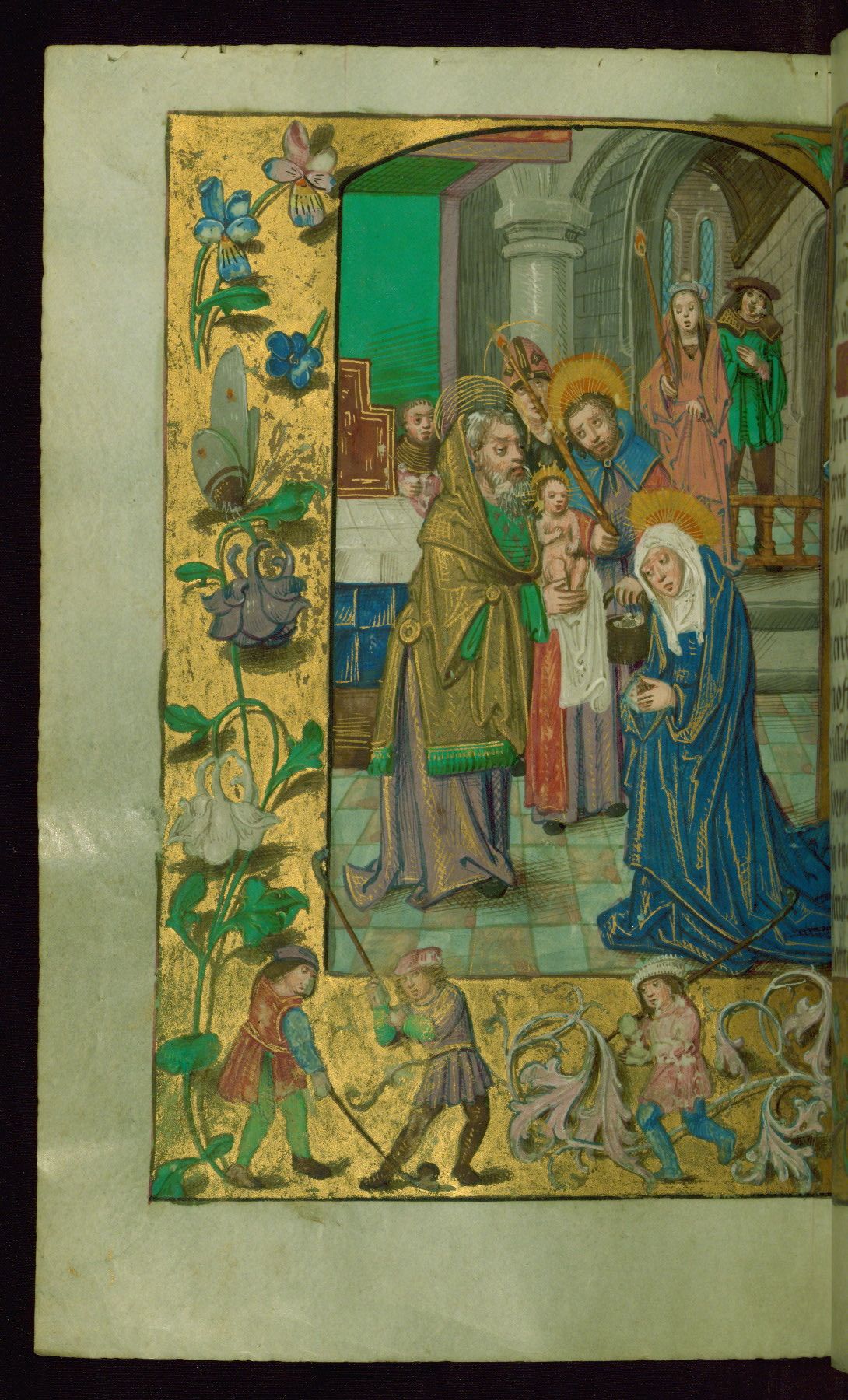
This book of hours, influenced by the Master of Edward IV and followers, wins the prize for most fun and playful border illumination. In the borders above three youngsters play golf. Unfortunately the binding was very tight and (playing it safe) I was not able to crack the book more than a few inches open, so I'm mostly looking at it afresh in the online catalogue.
In addition to such lively scenes of Burgundian secular life, several of the borders act as an extension into the main scene of the miniature.

For instance, in the Raising of Lazarus scene above, Christ himself stands in the golden border, outside the frame of the main miniature. This is certainly unusual and creative, but it is borderline overly done when half the scene is taking place in the border area. Perhaps the artist saw a more subtle implementation of an illusionary technique and excitedly took it a few steps further.

This unusual Annunciation to the Sheperds includes a Sheperdess. It's an unusual depiction, and unusual even to see main female characters in a miniature in peasant clothing. There is also a country house in the background with a nice amount of detail, which is a welcome change in architecture from the typical depiction of fortified castle style buildings and cities in the backgrounds of books of hours in general.

Also interesting is the miniature of St. Claudius, which is worn down revealing a simple underdrawing.
Ms. W.439

From the Walters' catalogue: This Book of Hours was completed in the 1480s for Adolph, duke of Cleves, count of La Mack, lord of Ravenstein and Wijnendale (1425-92), and member of the entourage of the dukes of Burgundy until 1477 and thereafter in a position of personal trust under Archduke Maximilian, husband of Mary of Burgundy (d. 1482). The manuscript is highly illuminated and includes two portraits of Adolph of Ghent. The presence of an inscription by Anne of Burgundy (fol. 71r: "A / B votre mieulx aimee / Anne") suggests that she may have commissioned the volume. A full-page illumination of Adolph of Cleves' heraldry includes the collar of the Order of the Golden Fleece, an order of chivalry founded in Bruges by Philip III, duke of Burgundy.
This lavishly decorated Hours of Adolph, duke of Cleves was made for an important patron. As the catalogue entry notes, Adolph was a member of the Order of the Golden Fleece, which was a very exclusive club for the elite of the elite. Members would be able to wear an elaborate golden collar necklace with a hanging sheep pendant. Members of the order were typical patrons of some of the most richly illuminated works outside of the Burgundian rulers themselves. Actually, I've found that the collar of the golden fleece appears not once but three times in this book, as Adolph is proudly wearing it in both portraits.

The collar of the Order of the Golden Fleece is the necklace surrounding the coat of arms with interlocking rectangular bands and a small sheep hanging at the bottom.

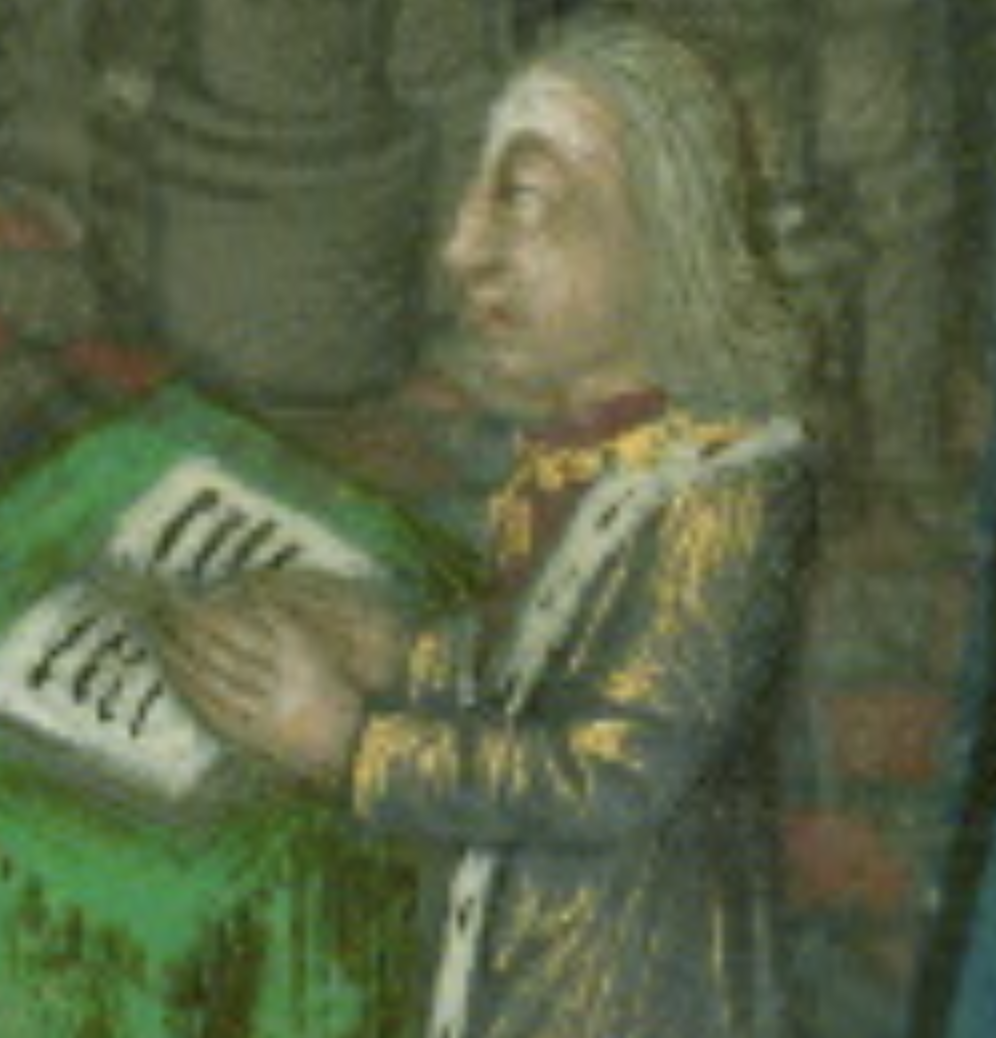
This is not atypical at all, as even the dukes of Burgundy were painted with their golden collars.

In the border of this page, you can spot a parallel idea to the w.270 manuscript: animals, in this case deer, with Catholic clergy attire. A little more subtle in this example, but interesting nonetheless.

Here we find a depiction of an archery competition, with targets attached to mounds, in the lower border. Probably it is not a coincidence it appears below the miniature of St Sebastian being shot with arrows.
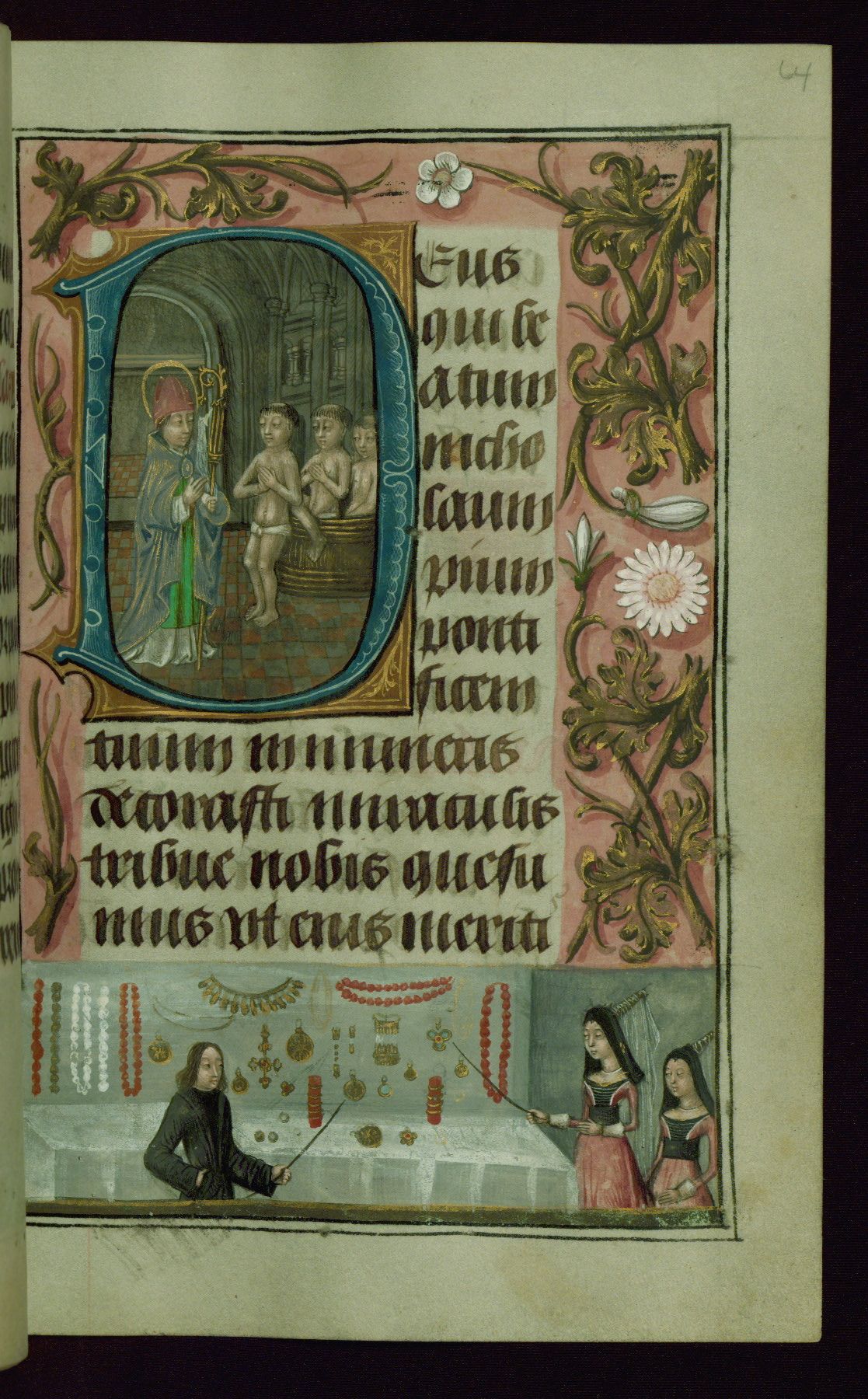
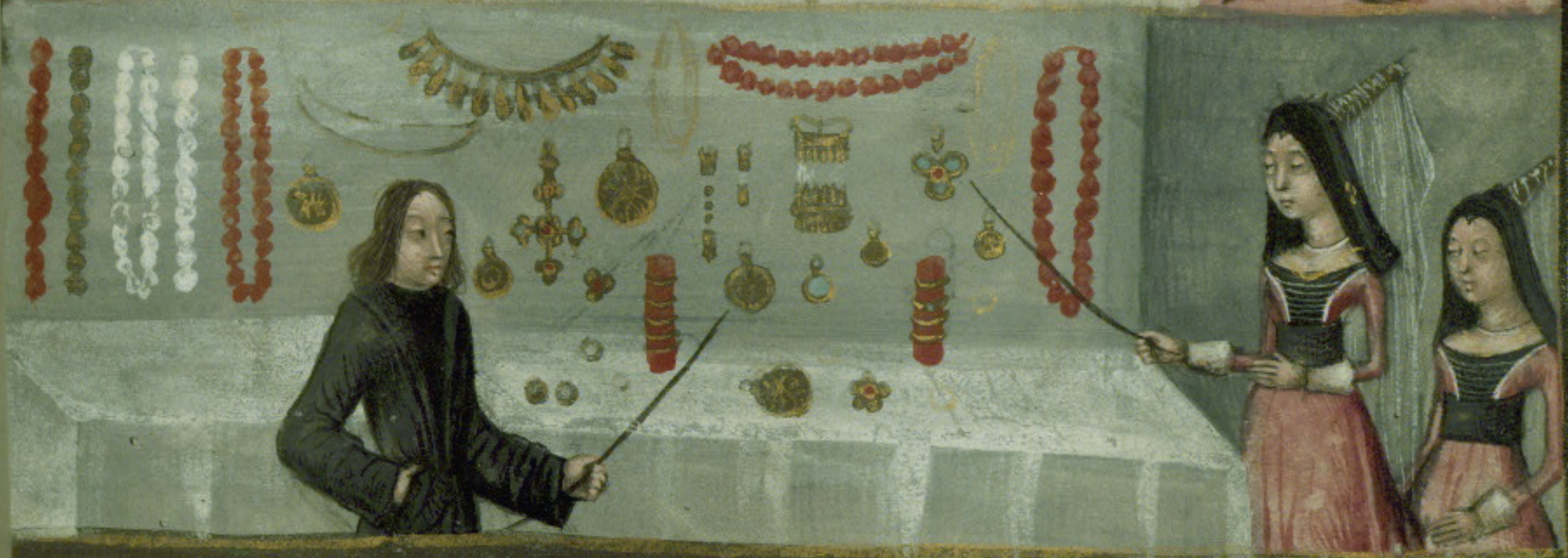
And here is one of the most interesting depictions of Burgundian secular life that I've seen in a miniature border, the interior of what appears to be a jewelry store, complete with a shopkeeper and wands used for pointing at the golden trinkets and coral beads on display.

Anne of Burgundy writes: "A / B Votre mieulx amie / Anne".
Thanks to the Walters staff for letting me study these manuscripts. Please let me know if you have any corrections or additional information on any of these.
